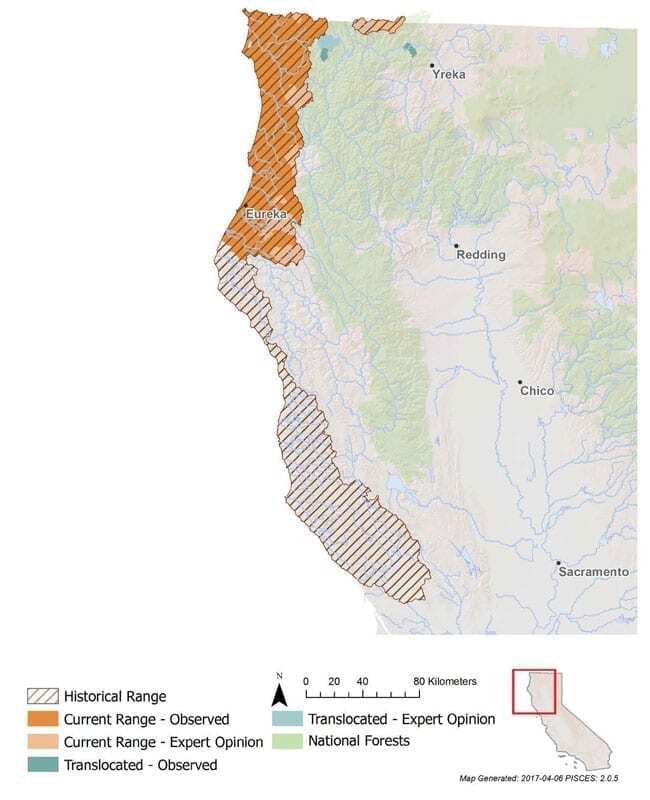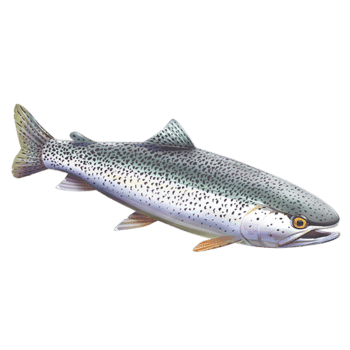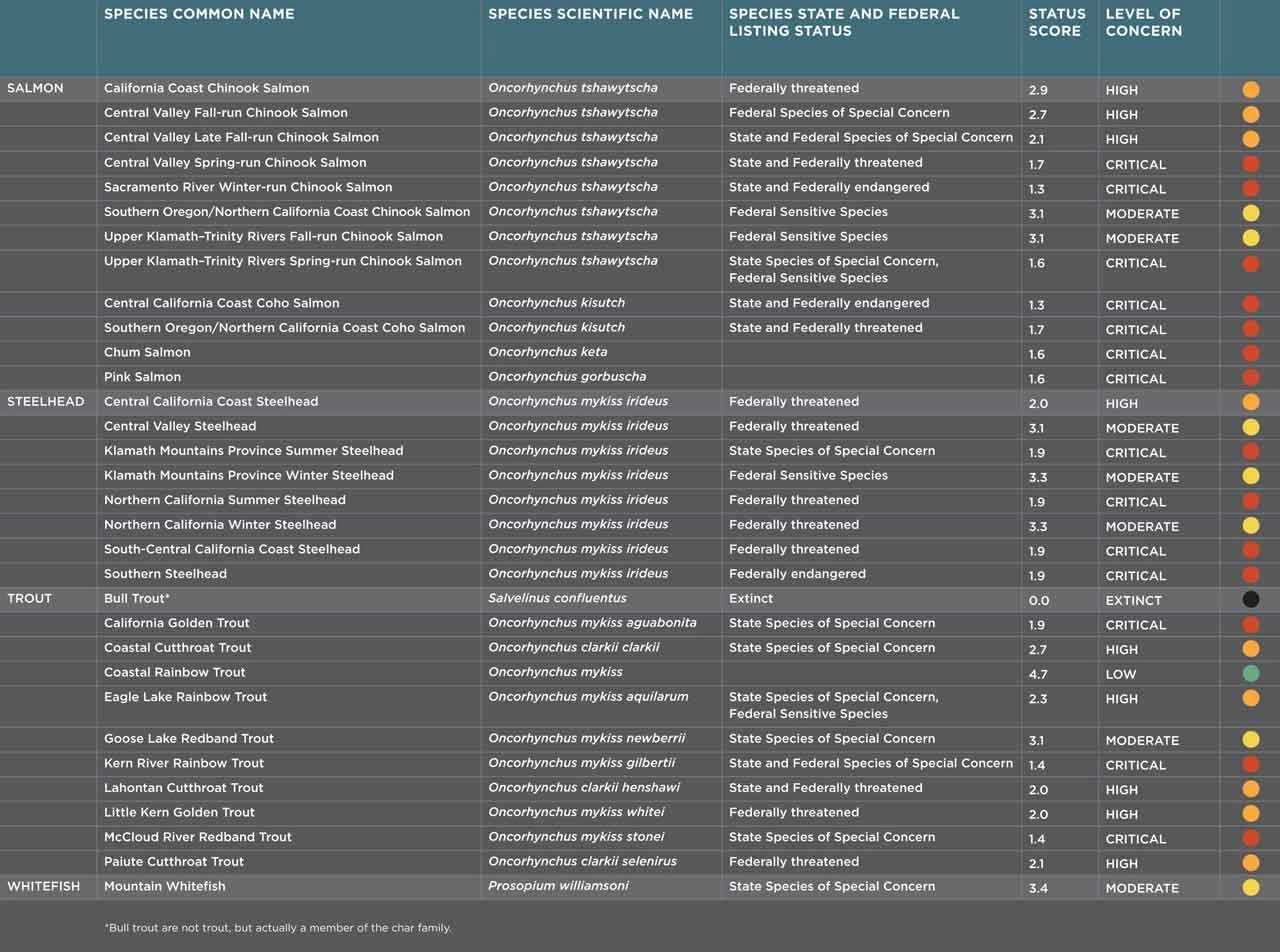How we're working to save them:
- Conduct abundance and distribution surveys to update information on the current status across their range in California.
- Conduct long-term monitoring and assessment to inform a conservation strategy for the species.
- Undertake estuary restoration in major watersheds to benefit all salmonids, such as in the Eel, Klamath, and Smith rivers and Redwood Creek.
Where to find Coastal Cutthroat Trout:
Coastal Cutthroat Trout Distribution
Coastal Cutthroat trout range from Prince William Sound, Alaska, to tributaries of the Salt River (Eel River, Humboldt County). They inhabit most coastal tributaries of major rivers open to the sea and lagoons between the Smith River (Del Norte County) and the Eel River (Humboldt County) in a relatively broad band along the coast. However, updated distribution surveys are needed for this species, as they often inhabit disconnected headwater streams that are now upstream of man-made barriers such as dams, diversions, and culverts.
How the Coastal Cutthroat Trout Scored:


Characteristics
Coastal Cutthroat trout are similar in appearance to Rainbow trout, but are generally brassy in color and have more spots spread along their bodies, especially on their fins. They are more slender and bullet-like in shape than Rainbow trout, with pointed heads and forked tails. As juvenile Coastal Cutthroats become smolts to undertake ocean migrations, their spots disappear and the fish become silvery. Most, but not all, Coastal Cutthroats have characteristic red to orange slashes under their lower jaws, though the slashes are rarely visible until the fish are a year or more old. They are capable of reaching 70 cm (about 28 in.) in length, and 8 kg (nearly 18 lbs.), but rarely exceed 40 cm (16 in.) in California waters. Tagged Coastal Cutthroats in California have been known to live for up to 7 years.
Abundance
Coastal Cutthroat trout once supported a substantial fishery and were even stocked in the Mad River (Humboldt County) as early as the 1920s to support harvest. Abundance data from California populations are typically incomplete and unpublished, but suggest that Coastal Cutthroat populations are probably significantly smaller than they were historically, and are either currently stable or in decline due to extensive estuary and stream alteration throughout their range in California.
Habitat & Behavior
Coastal Cutthroat trout are the least studied salmonid along the North Coast. They need cool, clean, oxygenated water with ample cover and deep pools for holding during the summer. They prefer small, low-gradient coastal streams with access to estuarine habitats, including lagoons, but may also live in small headwater streams. Coastal Cutthroats lurk in pools with fallen logs or undercut banks that provide shade and cover, where they can ambush small salmon, steelhead, and other fish. They may express one of four different life histories: (1) undertaking salt and fresh water migrations; (2) spending their lives in lakes; (3) dwelling in rivers but seasonally migrating to estuaries; or (4) remaining in small tributaries. Juveniles adopt a history based on habitat and food availability, water quality, temperature, and other environmental factors. Adults between two and four years of age migrate to natal streams after the first substantial rains in the fall, and spawn between December and April.
Genetics
California’s Coastal Cutthroat populations are at the southern end of their range, and are considered part of the Southern Oregon-California Coast DPS for management. While separate species, Coastal Cutthroat and Rainbow trout hybridize naturally, but differences in spawning timing, habitat preferences, and behavior keep them distinct in watersheds where they overlap. In watersheds where hatchery-origin steelhead are present, higher rates of hybridization between the two species have been documented.








 Dams block access to historical spawning and rearing habitats. Downstream, dams alter the timing, frequency, duration, magnitude, and rate of change of flows decreasing habitat quality and survival.
Dams block access to historical spawning and rearing habitats. Downstream, dams alter the timing, frequency, duration, magnitude, and rate of change of flows decreasing habitat quality and survival.


 Human use of streams, lakes, and surrounding watersheds for recreation has greatly increased with population expansion. Boating, swimming, angling, off-road vehicles, ski resorts, golf courses and other activities or land uses can negatively impact salmonid populations and their habitats. The impacts are generally minor; however, concentration of multiple activities in one region or time of year may have cumulative impacts.
Human use of streams, lakes, and surrounding watersheds for recreation has greatly increased with population expansion. Boating, swimming, angling, off-road vehicles, ski resorts, golf courses and other activities or land uses can negatively impact salmonid populations and their habitats. The impacts are generally minor; however, concentration of multiple activities in one region or time of year may have cumulative impacts.













